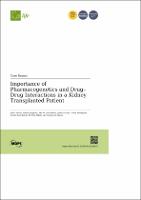Por favor, use este identificador para citar o enlazar este ítem:
https://repositorio.usj.es/handle/123456789/1173
Registro completo de metadatos
| Campo DC | Valor | Lengua/Idioma |
|---|---|---|
| dc.contributor.author | Concha Mayayo, Julia | - |
| dc.contributor.author | Sangüesa, Estela | - |
| dc.contributor.author | Sáez-Benito, Ana M. | - |
| dc.contributor.author | Aznar, Ignacio | - |
| dc.contributor.author | Berenguer, Nuria | - |
| dc.contributor.author | Sáez-Benito, Loreto | - |
| dc.contributor.author | Ribate, Mª Pilar | - |
| dc.contributor.author | García García, Cristina Belén | - |
| dc.date.accessioned | 2024-06-13T10:13:47Z | - |
| dc.date.available | 2024-06-13T10:13:47Z | - |
| dc.date.issued | 2023-07-26 | - |
| dc.identifier.citation | Concha, J.; Sangüesa, E.; Saez-Benito, A.M.; Aznar, I.; Berenguer, N.; Saez-Benito, L.; Ribate, M.P.; García, C.B. Importance of Pharmacogenetics and Drug–Drug Interactions in a Kidney Transplanted Patient. Life 2023, 13, 1627. https://doi.org/10.3390/life13081627 | en_US |
| dc.identifier.uri | https://repositorio.usj.es/handle/123456789/1173 | - |
| dc.description.abstract | Tacrolimus (TAC) is a narrow-therapeutic-range immunosuppressant drug used after organ transplantation. A therapeutic failure is possible if drug levels are not within the therapeutic range after the first year of treatment. Pharmacogenetic variants and drug–drug interactions (DDIs) are involved. We describe a patient case of a young man (16 years old) with a renal transplant receiving therapy including TAC, mycophenolic acid (MFA), prednisone and omeprazole for prophylaxis of gastric and duodenal ulceration. The patient showed great fluctuation in TAC blood concentration/oral dose ratio, as well as pharmacotherapy adverse effects (AEs) and frequent diarrhea episodes. Additionally, decreased kidney function was found. A pharmacotherapeutic follow-up, including pharmacogenetic analysis, was carried out. The selection of the genes studied was based on the previous literature (CYP3A5, CYP3A4, POR, ABCB1, PXR and CYP2C19). A drug interaction with omeprazole was reported and the nephrologist switched to rabeprazole. A lower TAC concentration/dose ratio was achieved, and the patient’s condition improved. In addition, the TTT haplotype of ATP Binding Cassette Subfamily B member 1 (ABCB1) and Pregnane X Receptor (PXR) gene variants seemed to affect TAC pharmacotherapy in the studied patient and could explain the occurrence of long-term adverse effects post-transplantation. These findings suggest that polymorphic variants and co-treatments must be considered in order to achieve the effectiveness of the immunosuppressive therapy with TAC, especially when polymedicated patients are involved. Moreover, pharmacogenetics could influence the drug concentration at the cellular level, both in lymphocyte and in renal tissue, and should be explored in future studies. | en_US |
| dc.format.extent | 14 p. | en_US |
| dc.format.mimetype | application/pdf | en_US |
| dc.language.iso | eng | en_US |
| dc.publisher | MDPI | en_US |
| dc.relation.requires | Adobe PDF | en_US |
| dc.rights | Atribución 4.0 Internacional | * |
| dc.rights.uri | http://creativecommons.org/licenses/by/4.0/ | * |
| dc.subject | Tacrolimus | en_US |
| dc.subject | Omeprazole | en_US |
| dc.subject | Renal transplant | en_US |
| dc.subject | Pharmacogenetics | en_US |
| dc.subject | Polymorphisms | en_US |
| dc.subject | Drug–drug interaction | en_US |
| dc.title | Importance of Pharmacogenetics and Drug-Drug Interactions in a Kidney Transplanted Patient | en_US |
| dc.type | journal article | en_US |
| dc.relation.publisherversion | https://www.mdpi.com/2075-1729/13/8/1627 | en_US |
| dc.identifier.publicationfirstpage | 1 | en_US |
| dc.identifier.publicationlastpage | 15 | en_US |
| dc.identifier.doi | https://doi.org/10.3390/life13081627 | en_US |
| dc.rights.accessRights | open access | en_US |
| Aparece en las colecciones: | Artículos de revistas | |
Ficheros en este ítem:
| Fichero | Descripción | Tamaño | Formato | |
|---|---|---|---|---|
| Importance of Pharmacogenetics and Drug–Drug.pdf | 835,91 kB | Adobe PDF |  Visualizar/Abrir |
Este ítem está sujeto a una licencia Creative Commons Licencia Creative Commons

